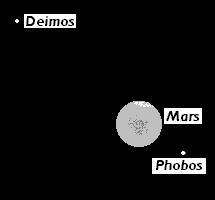Sighting Phobos
Roughly very two years, the Earth overtakes the planet Mars at what is called an opposition. At oppositions our distance to this small red planet is small. When oppositions occur in summer, Mars is as close while Earth is as far from the Sun as they get. This reduces the distance between them to a minimum. A very close opposition will occur this summer. In the summer of 2003 a much closer opposition will occur. Mars will come closer to Earth than it ever has since the invention of the telescope. This is the first opposition of Mars since Frosty Drew Observatory [FDO] installed its new large telescope. We can see dimmer and smaller objects than we ever have in the past. Towards the end of March we got an early sample of the great viewing we should have in July through September.What has us so excited is that for the first time at FDO is that we have sighted for the very first time one of the two tiny dim moons that circle Mars. What made this sighting more remarkable was that conditions were not very favorable for seeing at all. The air was unstable and there was a good deal of moisture in the air. I was trying to get a good view of the polar cap and a dark area which I though my be Syrtis Major. Suddenly out of the corner of my eye popped up a tiny scintillating point of light. From it proximity to Mars and its faintness, I was almost sure that it was a moon rather than a background star.When there is a difficult and possibly spurious sighting at FDO we have a practice of calling out the object, but not saying where we spotted it. We wait until all the seasoned observers have had a chance to view. Each keeps private notes until we compare them. Each of us had seen the same point of light roughly at "4:30" if we treat the face of Mars as a clock. Of the five observers in the dome at the time, only one of us was a new hand. The old hands have a combined viewing experience of more than 135 years to call upon. However none of us had ever seen a moon of Mars before this night.We had not expected to see either moon so we had not looked up its positions ahead of time. Given that Deimos is usually easier to see because it is farther from the glare of Mars, we suspected it was Deimos. While we have software which calculates extremely high position coordinates for the moons of Mars, Jupiter, Saturn, and Uranus, it wasn't installed on our computer in the Dome. We had to wait until morning to get a confirmation that indeed a moon of Mars was exactly where we had seen it at 2:37 AM. Only the moon was the more difficult inner moon Phobos. Had we not been so convinced that we were looking at the outer moon we could probably also have seen Deimos up left of the planet.You can get some sense of the personal achievement this was for our band of observers if you realize that seeing Phobos is approximately as easy to see as a firefly sitting two inches from a car headlight several miles away. Phobos never gets much more than about 6000 miles from the center of Mars. Since Mars has a radius of 4144 miles, Phobos is always close to the planet in our eyepieces. Another indication of how hard these little moons are to see is that moons had been seen around Jupiter in 1610 (when Galileo first turned a telescope on the planet), around Saturn in 1655, around Uranus in 1787 (only six years after Uranus was discovered) and around Neptune in 1846 (at the same time the planet was found). However, Mars two small moons, which come more than ten times closer than any other moons [except our Moon of course] were not found until 1877 by Asaph Hall using the United States Naval Observatory's 26 inch refractor (then the largest refracting telescope in the world, and still the second largest refractor). I think you understand the sense of the excitement we all felt.Finding Phobos would be enough to justify a trip to FDO. Yet it was only one of 20 new first time sighting that evening. Of course, this leads me to the point I've been working towards all evening. FDO is a wonderful resource for South County. We love to provide an opportunity for visitors to see the wonders of the sky above our heads. We invite you on any clear Friday night after dusk. We'll be looking forward to seeing you - at least when we aren't looking though the eyepieces at something like Phobos.
- Author:
- Leslie Coleman
- Entry Date:
- Apr 1, 2001
- Published Under:
- Leslie Coleman's Columns


